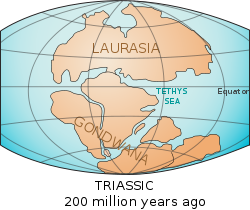Difference between revisions of "Laurasia" - New World Encyclopedia
Rick Swarts (talk | contribs) (added article from Wikipedia and credit/category tags) |
Rick Swarts (talk | contribs) |
||
| Line 1: | Line 1: | ||
| − | |||
[[Image:Laurasia-Gondwana.svg|right|thumb|250px]] | [[Image:Laurasia-Gondwana.svg|right|thumb|250px]] | ||
'''Laurasia''' ({{pron-en|lɔːˈreɪʒə}}, {{IPAlink-en|lɔːˈreɪʃiə}}<ref>OED</ref>) was a [[supercontinent]] that most recently existed as a part of the split of the [[Pangaea]]n supercontinent in the late [[Mesozoic]] [[era (geology)|era]]. It included most of the landmasses which make up today's continents of the [[northern hemisphere]], chiefly [[Laurentia]] (the name given to the North American craton), [[Baltica]], [[Siberia (continent)|Siberia]], [[Kazakhstania]], and the [[North China Craton|North China]] and [[East China Craton|East China]] [[craton]]s. | '''Laurasia''' ({{pron-en|lɔːˈreɪʒə}}, {{IPAlink-en|lɔːˈreɪʃiə}}<ref>OED</ref>) was a [[supercontinent]] that most recently existed as a part of the split of the [[Pangaea]]n supercontinent in the late [[Mesozoic]] [[era (geology)|era]]. It included most of the landmasses which make up today's continents of the [[northern hemisphere]], chiefly [[Laurentia]] (the name given to the North American craton), [[Baltica]], [[Siberia (continent)|Siberia]], [[Kazakhstania]], and the [[North China Craton|North China]] and [[East China Craton|East China]] [[craton]]s. | ||
Revision as of 22:24, 2 June 2009
Laurasia (pronounced /lɔːˈreɪʒə/, /lɔːˈreɪʃiə/[1]) was a supercontinent that most recently existed as a part of the split of the Pangaean supercontinent in the late Mesozoic era. It included most of the landmasses which make up today's continents of the northern hemisphere, chiefly Laurentia (the name given to the North American craton), Baltica, Siberia, Kazakhstania, and the North China and East China cratons.
The name combines the names of Laurentia and Eurasia.
Origin
Although Laurasia is known as a Mesozoic phenomenon, today it is believed that the same continents that formed the later Laurasia also existed as a coherent supercontinent after the breakup of Rodinia around 1 billion years ago. To avoid confusion with the Mesozoic continent, this is referred to as Proto-Laurasia. It is believed that Laurasia did not break up again before it recombined with the southern continents to form the late Precambrian supercontinent of Pannotia, which remained until the early Cambrian. Laurasia was assembled, then broken up, due to the actions of plate tectonics, continental drift and seafloor spreading.
Break up and reformation
During the Cambrian, Laurasia was largely located in equatorial latitudes and began to break up, with North China and Siberia drifting into latitudes further north than those occupied by continents during the previous 500 million years. By the Devonian, North China was located near the Arctic Circle and it remained the northernmost land in the world during the Carboniferous Ice Age between 300 and 280 million years ago. There is no evidence, though, for any large scale Carbonifeous glaciation of the northern continents. This cold period saw the re-joining of Laurentia and Baltica with the formation of the Appalachian Mountains and the vast coal deposits which are today a mainstay of the economy of such regions as West Virginia, the United Kingdom and Germany.
Siberia moved southwards and joined with Kazakhstania, a small continental region believed today to have been created during the Silurian by extensive volcanism. When these two continents joined together, Laurasia was nearly reformed, and by the beginning of the Triassic, the East China craton had rejoined the redeveloping Laurasia as it collided with Gondwana to form Pangaea. North China became, as it drifted southwards from near-Arctic latitudes, the last continent to join with Pangaea.
Final split
Around 200 million years ago, Pangaea started to break up. Between eastern North America and northwest Africa, a new ocean formed - the Atlantic Ocean, even though Greenland (attached to North America) and Europe were still joined together. The separation of Europe and Greenland occurred around 60 million years ago (in the Paleocene). Laurasia finally divided into the continents after which it is named: Laurentia (now North America) and Eurasia (excluding India and Arabia).
See also
- Alexander du Toit
- Alfred Wegener
- Avalonia
ReferencesISBN links support NWE through referral fees
- ↑ OED
Africa-Eurasia |
Americas |
Eurasia |
Oceania | ||||||||||||||||||||||||
Africa |
Antarctica |
Asia |
Australia |
Europe |
N. America |
S. America | |||||||||||||||||||||
|
Geological supercontinents Gondwana • Laurasia • Pangaea • Pannotia • Rodinia • Columbia • Kenorland • Ur • Vaalbara | |||||||||||||||||||||||||||
|
Mythical and theorized continents Atlantis • Kerguelen Plateau • Lemuria • Mu • Terra Australis • Zealandia | |||||||||||||||||||||||||||
Credits
New World Encyclopedia writers and editors rewrote and completed the Wikipedia article in accordance with New World Encyclopedia standards. This article abides by terms of the Creative Commons CC-by-sa 3.0 License (CC-by-sa), which may be used and disseminated with proper attribution. Credit is due under the terms of this license that can reference both the New World Encyclopedia contributors and the selfless volunteer contributors of the Wikimedia Foundation. To cite this article click here for a list of acceptable citing formats.The history of earlier contributions by wikipedians is accessible to researchers here:
The history of this article since it was imported to New World Encyclopedia:
Note: Some restrictions may apply to use of individual images which are separately licensed.
